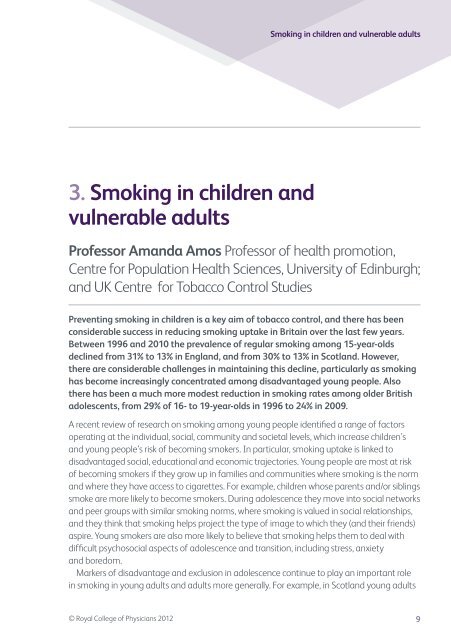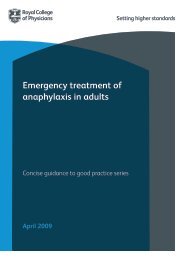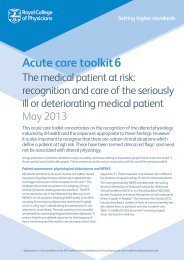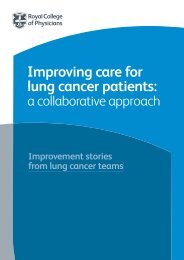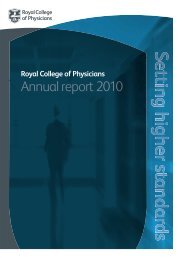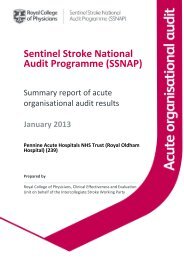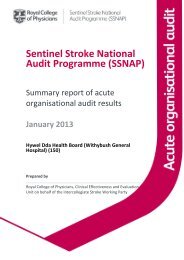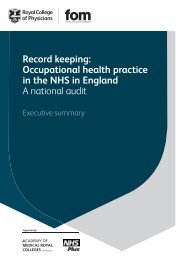Fifty years since Smoking and health - Royal College of Physicians
Fifty years since Smoking and health - Royal College of Physicians
Fifty years since Smoking and health - Royal College of Physicians
You also want an ePaper? Increase the reach of your titles
YUMPU automatically turns print PDFs into web optimized ePapers that Google loves.
3. <strong>Smoking</strong> in children <strong>and</strong><br />
vulnerable adults<br />
<strong>Smoking</strong> in children <strong>and</strong> vulnerable adults<br />
Pr<strong>of</strong>essor Am<strong>and</strong>a Amos Pr<strong>of</strong>essor <strong>of</strong> <strong>health</strong> promotion,<br />
Centre for Population Health Sciences, University <strong>of</strong> Edinburgh;<br />
<strong>and</strong> UK Centre for Tobacco Control Studies<br />
Preventing smoking in children is a key aim <strong>of</strong> tobacco control, <strong>and</strong> there has been<br />
considerable success in reducing smoking uptake in Britain over the last few <strong>years</strong>.<br />
Between 1996 <strong>and</strong> 2010 the prevalence <strong>of</strong> regular smoking among 15-year-olds<br />
declined from 31% to 13% in Engl<strong>and</strong>, <strong>and</strong> from 30% to 13% in Scotl<strong>and</strong>. However,<br />
there are considerable challenges in maintaining this decline, particularly as smoking<br />
has become increasingly concentrated among disadvantaged young people. Also<br />
there has been a much more modest reduction in smoking rates among older British<br />
adolescents, from 29% <strong>of</strong> 16- to 19-year-olds in 1996 to 24% in 2009.<br />
A recent review <strong>of</strong> research on smoking among young people identifi ed a range <strong>of</strong> factors<br />
operating at the individual, social, community <strong>and</strong> societal levels, which increase children’s<br />
<strong>and</strong> young people’s risk <strong>of</strong> becoming smokers. In particular, smoking uptake is linked to<br />
disadvantaged social, educational <strong>and</strong> economic trajectories. Young people are most at risk<br />
<strong>of</strong> becoming smokers if they grow up in families <strong>and</strong> communities where smoking is the norm<br />
<strong>and</strong> where they have access to cigarettes. For example, children whose parents <strong>and</strong>/or siblings<br />
smoke are more likely to become smokers. During adolescence they move into social networks<br />
<strong>and</strong> peer groups with similar smoking norms, where smoking is valued in social relationships,<br />
<strong>and</strong> they think that smoking helps project the type <strong>of</strong> image to which they (<strong>and</strong> their friends)<br />
aspire. Young smokers are also more likely to believe that smoking helps them to deal with<br />
diffi cult psychosocial aspects <strong>of</strong> adolescence <strong>and</strong> transition, including stress, anxiety<br />
<strong>and</strong> boredom.<br />
Markers <strong>of</strong> disadvantage <strong>and</strong> exclusion in adolescence continue to play an important role<br />
in smoking in young adults <strong>and</strong> adults more generally. For example, in Scotl<strong>and</strong> young adults<br />
© <strong>Royal</strong> <strong>College</strong> <strong>of</strong> <strong>Physicians</strong> 2012 9


